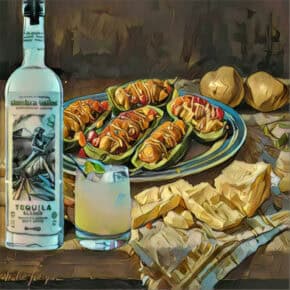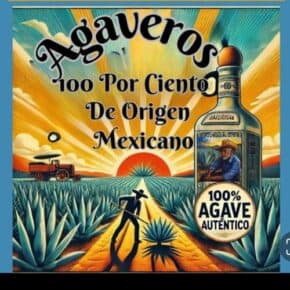
It’s the crime of the century and Chantal Martineau’s How the Gringos Stole Tequila: The Modern Age of Mexico’s Most Traditional Spiritexplains exactly how they got away with it. The real questions you’re left debating are whether that theft was the fruit of circumstance and whether the damage can be repaired. But, really, this is no true crime book, it’s a walk through the history and present of the agave spirits industry told through a series of encounters with some of the brighter and more interesting personalities that rule it.
To start, it’s incredibly encouraging to see this book do away with any pretense of a dualism between tequila and mezcal. At least in these pages, all agave spirits are part of one big happy family and history. Hell, a bottle of Mezcales de Leyenda even appears on the cover telegraphing just how prominent a role our favored spirit occupies in this narrative.
This story is told through personal profiles. Each chapter is anchored by an encounter with one of the universe of fascinating characters in the business like Guillermo Sauza who leads Tequila Fortaleza or Pedro Jiménez Gurría who created Mezonte in Guadalajara. Those interviews provide clear contrasts that define the industry. The perfectly manicured Disneyland that Patrón uses to define its tequila is brought face-to-face with shivering jimadores heading to work at dawn. Chantal Martineau is very intent in making sure that we grasp just how idealized the romanticism of tequila’s marketing is, and even concludes the book with a note of profound disillusionment about her own role in this process.
But the book is animated by one big idea which she wouldn’t have arrived at without seeing the sausage making that defines this branding. It’s that without the massive North American market, its changing tastes, and its obsession with branding, tequila may have remained something of a regional phenomenon. Take one simple example, the margarita, which is probably the most popular cocktail on the planet, definitely in the United States. It’s most likely a creation of North Americans, it’s definitely where most tequila production ends up. As a consequence, most tequila is created just for that purpose.
One of the most entertaining and emblematic examples is the story of Patrón which Chantal tells with aplomb. It encapsulates everything in this book and the evolutionary process of the spirits business in Mexico over the past thirty years. The brand was started by two men but John Paul Jones DeJoria’s name gets the marquee treatment because he was the creator and remains the literal face of Paul Mitchell Hair Systems. Remember all those white plastic bottles that brought hard edged fonts to hair care products? Remember his well coiffed beard and ponytail? This is the guy who defined the face and coiffure of the United States in the 80’s. He’s also a literal rags to riches story; a living, breathing Horatio Alger for our era.
His partner Martin Crowley found the tequila that the pair decided would be the start of their business which used all the classic branding know how that makes Mad Men click. There are some fantastically entertaining details on how it came together and redefined what people expected of tequila but the real crux of the brand was that it wanted to embody the artisanal ideal. As Patrón scaled up to stratospheric heights it left the actual artisanal production methods and the family that it contracted with to create the original Patrón tequila behind. That family fell out with Patrón and went on to create 7 Leguas while Patrón went on to create one of the biggest distilling operations in the business. And that’s the major lesson of the book and our whole cross border relationship.
That pursuit of authenticity, at least the idea of it, has been the driving force in tequila. It remains the driving force in mezcal. And it’s probably the predominant illusion of our time. We’re still trying to figure it all out without any great solution. As Chantal puts it:
“So, yes, tequila is a truly Mexican product. But it’s also an American product – for better or worse. Made in Mexico, its image has long been shaped by American sensibilities. Yet somewhere along the way, part of the story gets lost in translation. What’s missing from the narrative is how tequila went from being just another mezcal to the billion-dollar industry it is today.”
But one of the more fascinating and larger themes that runs through the book is that tequila is really a product of the nineteenth century, a product of the era of industrialization and large land holding in Mexico. Just as Europeans were creating fantastic liquors and bitters with iconic branding campaigns that still resonate like this one: 
The crux of the question about where we’re headed is caught up in the collision of branding tequila and mezcal as authentically Mexican. Chantal puts it rather succinctly “From Mexican cowboy drink to terroir driven sipping spirit, tequila’s changing image is a reflection of changing American values.” That’s where mezcal really comes into the equation because it’s both that rough hewn cowboy and terroir driven product, it never changed, at least in so far as the branding is concerned. Mezcal lovers know that there’s still plenty of truth to it but the definitional struggle is upon us.
Lest there be any mezcal triumphalism she clearly points out just how much influence North Americans continue to exert on the mezcal world. Whether it’s through businessmen like Ron Cooper who was the first to really succeed with mezcal north of the border or bartenders like Bobby Heugel who has been instrumental in maintaining the artisanal designation of the spirit – gringos may not be stealing mezcal but they are defining it as economic and cultural forces.
That leads to one of the more interesting and persistent ideas in the book – while tequila has a great brand based on its well defined appellation, that same obsession with a precise definition of exactly what can go into a bottle of tequila may also be part of its downfall. While the tequila industry looks at “100% blue agave” as a key branding distinction, it may also be a monocultural time bomb. And, it may not actually matter that much to customers because their idea of authenticity has moved even further afar. It feels like brand tequila is stuck in the 20th century while it’s high end consumer base has moved on to another set of concerns.
As Chantal points out “tequila and mezcal are arguably the most terroir-driven spirits out there: they’re made from an indigenous raw material that is native and unique to Mexico. The local climate, soil, topography, and human tradition have a significant effect on how the tequila or mezcal ends up tasting.” But that obsession with making tequila exactly like Champagne in name while so aggressively industrializing its production is one of the major issues in sustaining it. If you think that’s a tough issue think about what’s next: China – The largest market in the world which is finding a taste for tequila. Given the transformational relationship with the US, who knows what China will do with tequila and mezcal.
Like many, this book concludes with recommendations on which spirits to seek out with the greatest of provisos that I’ll quote in full because it should be a part of every book like this:
Now, tasting notes can be a bit silly. This is especially true of small-batch spirits, like many of the mezcales included in this guide. It’s not just that taste is subjective, a consequence of a person’s biology plus all the flavor and aroma memories accumulated over a lifetime, but that small-batch products are rather likely to change from one batch to the next. Each new bottling from the smallest mezcal producers and even certain tequila producers can be expected to show distinct characteristics, depending on the weather and other conditions unique to each harvest. So I’ve kept tasting notes to a minimum.
Now that’s a statement that we fully endorse. And should you want to dive into the world of agave spirits any further, plumb the bibliography.













Leave a Comment